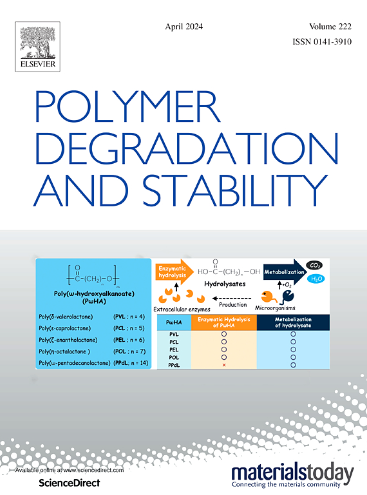Fabrication of thin-walled flame-retardant recycled polyethylene composites: synergistic flame retardancy of muscovite in APP/MCA systems
IF 7.4
2区 化学
Q1 POLYMER SCIENCE
引用次数: 0
Abstract
Thin-walled flame-retardant recycled polyethylene (rPE) materials can be applied in packaging liners for precision instruments and medical equipment. To prepare thin-walled flame-retardant rPE, a series of rPE composites were fabricated through melt extrusion using rPE as the matrix, ammonium polyphosphate (APP) and melamine cyanurate (MCA) as flame retardants, and muscovite (Mus) as a flame-retardant synergist. The flame retardancy, thermal performance, and mechanical properties of the composites were analyzed using a vertical burning tester, oxygen index analyzer, cone calorimeter, thermogravimetric analyzer, and universal testing machine. The results revealed that when the mass ratio of APP to MCA was 3:1, it exhibited the optimal flame retardant effect in rPE. The rPE/33(3#APP/MCA) composite demonstrated an LOI of 31.2 % and achieved a UL94 2.5 mm V-0 flame rating. Compared with pure rPE, its tensile strength and notched impact strength decreased by 38.9 % and 77.9 %, respectively. The flame retardancy and strength of the rPE/(3#APP/MCA)/Mus composites initially increased and then decreased with increasing Mus addition level, while the thermal stability and toughness gradually increased. The rPE/29(3#APP/MCA)/4Mus composite exhibited an LOI of 33.7 % and achieved a UL 94 2.0 mm V-0 flame rating. Compared with rPE/33(3#APP/MCA), the TTI, FPI, T5 %, Tmax, tensile strength, flexural strength, and notched impact strength increased by 6.0 %, 54.2 %, 19.3 °C, 21.7 °C, 46.6 %, 27.8 %, and 61.4 %, respectively, the PHRR, AHRR, and THR decreased by 29.9 %, 16.7 %, and 21.4 %, respectively. An appropriate amount of Mus synergized with 3#APP/MCA for flame retardancy in rPE. When 37 % of the compound flame retardant Mus/APP/MCA (Mus:3#APP/MCA=4:29) was incorporated into rPE, the rPE/37(APP/MCA/Mus) composite achieved an LOI of 38.2 % and a UL94 1.0 mm V-0 flame rating.
薄壁阻燃再生聚乙烯复合材料的制备:白云母在APP/MCA体系中的协同阻燃性
薄壁阻燃再生聚乙烯(rPE)材料可用于精密仪器和医疗设备的包装衬里。为制备薄壁阻燃rPE,以rPE为基体,以聚磷酸铵(APP)和三聚氰胺氰脲酸酯(MCA)为阻燃剂,以白云母(Mus)为阻燃增塑剂,通过熔融挤出法制备了一系列rPE复合材料。采用垂直燃烧试验机、氧指数分析仪、锥形量热仪、热重分析仪和万能试验机对复合材料的阻燃性、热性能和力学性能进行了分析。结果表明,APP与MCA的质量比为3:1时,在rPE中阻燃效果最佳。rPE/33(3#APP/MCA)复合材料的LOI为31.2%,达到UL94 2.5 mm V-0火焰等级。与纯rPE相比,其抗拉强度和缺口冲击强度分别降低了38.9%和77.9%。随着Mus添加量的增加,rPE/(3#APP/MCA)/Mus复合材料的阻燃性和强度先升高后降低,热稳定性和韧性逐渐提高。rPE/29(3#APP/MCA)/4Mus复合材料的LOI为33.7%,火焰等级达到UL 94 2.0 mm V-0。与rPE/33(3#APP/MCA)相比,TTI、FPI、t5%、Tmax、拉伸强度、抗弯强度和缺口冲击强度分别提高了6.0%、54.2%、19.3°C、21.7°C、46.6%、27.8%和61.4%,PHRR、AHRR和THR分别降低了29.9%、16.7%和21.4%。适量的Mus与3#APP/MCA协同作用,在rPE中起阻燃作用。当复合阻燃剂Mus/APP/MCA (Mus:3#APP/MCA=4:29)的37%加入到rPE中时,rPE/37(APP/MCA/Mus)复合材料的LOI为38.2%,阻燃等级为UL94 1.0 mm V-0。
本文章由计算机程序翻译,如有差异,请以英文原文为准。
求助全文
约1分钟内获得全文
求助全文
来源期刊

Polymer Degradation and Stability
化学-高分子科学
CiteScore
10.10
自引率
10.20%
发文量
325
审稿时长
23 days
期刊介绍:
Polymer Degradation and Stability deals with the degradation reactions and their control which are a major preoccupation of practitioners of the many and diverse aspects of modern polymer technology.
Deteriorative reactions occur during processing, when polymers are subjected to heat, oxygen and mechanical stress, and during the useful life of the materials when oxygen and sunlight are the most important degradative agencies. In more specialised applications, degradation may be induced by high energy radiation, ozone, atmospheric pollutants, mechanical stress, biological action, hydrolysis and many other influences. The mechanisms of these reactions and stabilisation processes must be understood if the technology and application of polymers are to continue to advance. The reporting of investigations of this kind is therefore a major function of this journal.
However there are also new developments in polymer technology in which degradation processes find positive applications. For example, photodegradable plastics are now available, the recycling of polymeric products will become increasingly important, degradation and combustion studies are involved in the definition of the fire hazards which are associated with polymeric materials and the microelectronics industry is vitally dependent upon polymer degradation in the manufacture of its circuitry. Polymer properties may also be improved by processes like curing and grafting, the chemistry of which can be closely related to that which causes physical deterioration in other circumstances.
 求助内容:
求助内容: 应助结果提醒方式:
应助结果提醒方式:


